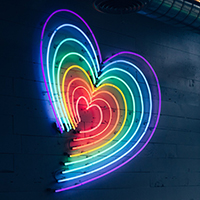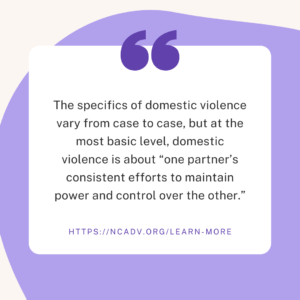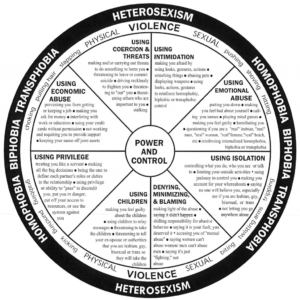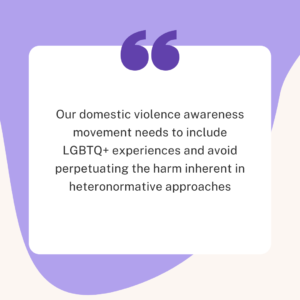Queering our understanding of domestic violence
 Get ready for a blog post full of acronyms!
Get ready for a blog post full of acronyms!
October is Domestic Violence Awareness Month (DVAM). The National Coalition Against Domestic Violence (NCADV) began observing DVAM back in the ’80s as an effort to get domestic violence (DV) service providers collaborating and problem-solving. Since the ‘80s, advocates have continued mobilizing communities to promote DV awareness and prevention and improve the support available to victim-survivors.
This year at the U, departments across campus have been hosting healthy relationship classes, gathering letters for survivors, creating art installations, and boosting awareness about domestic violence in other creative ways. As a queer woman and an advocate for victim-survivors of DV, I want to contribute to DVAM efforts this year by centering our awareness on the impact of DV on LGBTQ+ members of our campus community.
What does it mean to center LGBTQ+ experiences when talking about DV?
First, let’s take a step back: what do we mean by DV? DV can refer to several types of intimate partner violence (IPV- there’s a bonus acronym!), including dating violence and stalking. DV doesn’t necessarily have to include marriage, cohabitation, or sexual history. DV also doesn’t necessarily have to include physical abuse. DV can look like an ex-partner calling 18 times in one hour and threatening to come over if they don’t get a response. DV can look like a current partner isolating their partner from friends and family and insisting on having constant access to their location or not allowing them to go anywhere alone. The specifics of DV vary from case to case, but at the most basic level, DV is about “one partner’s consistent efforts to maintain power and control over the other” (https://ncadv.org/learn-more). With this context, we can start to “queer” our understanding of DV.

We typically raise awareness of DV through a very heteronormative lens, meaning the experiences of cisgender, straight people are front and center. This narrative implicitly and explicitly portrays the victim-survivors as straight, cis women and the perpetrators as straight cis men. Intersections of age, race, and disability also appear in these narratives since the characters often tend to be middle-aged, white, and nondisabled. This heteronormative narrative informs our DV policies, practices, and program. For example, we set up women-only DV shelters, pass out brochures for victim-survivors that only feature women and feminine pronouns, and write laws that only apply to male perpetrators. These approaches reinforce the myth that LGBTQ+ people don’t experience and make victim-survivors invisible.
In reality, people of any gender or sexuality can experience domestic violence. The NCADV says, “Because the majority of the domestic violence awareness movement has focused on heterosexual relationships, members of the LGBTQ community have been largely left out of the movement. However, recent research shows that LGBTQ members fall victim to domestic violence at equal or even higher rates compared to their heterosexual counterparts.” Check out some supporting statistics on NCADV’s website. Let’s take a closer look at some of the specific ways DV impacts LGBTQ+ people.
The SafeHouse Center created a Power and Control Wheel for LBGTQ+ Relationships that centers LGBTQ+ experiences with DV. This graphic provides examples of how abusive partners attempt to gain power and control and exploit vulnerabilities specific to their LGBTQ+ partners. For example, this graphic points out how abusive partners can threaten to “out” their partner, which could damage their social support system and isolate them. Abusive partners can also do emotional harm with statements like “no one else will ever love you like I do, because you’re not a ‘real’ man/woman/lesbian/etc.” which reinforces internalized homophobia, shame, and dysmorphia.

LGBTQ+ victim-survivors face specific barriers to seeking support too. LGBTQ+ communities can be small and insular, so victim-survivors may fear being ostracized if they come forward. LGBTQ+ survivors may worry that no one will believe them if their DV doesn’t fit the typical narrative of male-on-female violence. They may not have access to organizations that provide services to victim-survivors of their gender or sexuality. Heteronormative state laws may make prosecuting cases of LGBTQ+ victim-survivors difficult, or the laws may not recognize their case as DV at all.
Our domestic violence awareness movement needs to include LGBTQ+ experiences and avoid perpetuating the harm inherent in heteronormative approaches. So, how can we make our prevention efforts more inclusive, and how can we better connect LGBTQ+ victim-survivors with quality resources? Systemic change will take a lot of time and advocacy, but here are some ways you can start making a difference in your community:
- Believe victim-survivors regardless of their gender, gender expression, or sexuality.
- Use gender-inclusive language when talking about DV.
- Avoid making assumptions about the gender or sexuality of DV victim-survivors and perpetrators.
- Identify an LGBTQ+ affirming resource for DV victim-survivors (like those listed below!).
- Recognize heteronormative DV myths when you see them in the media, hear them in conversation, etc. Call those myths out!
- Have a conversation about heteronormative DV myths with your friend group.
- Get involved with organizations that advocate for policies that protect LGBTQ+ Utahns (like Equality Utah).

Thanks for reading! And thanks for being willing to do the hard work it will take to make our campus a place where people of any gender or sexuality can feel safe and supported.
Need Support?
- Schedule an appointment with the U’s confidential Victim-Survivor Advocates
- 24/7 UDVC LINK line 1-800-897-LINK (5465)
- 24/7 Strong Hearts Native Hotline 1-844-7NATIVE (762-8483)
- 24/7 The Network / La Red (serves people who are LGBTQ, poly, and kink/BDSM) 1-617-742-4911
Additional Resources
*A note about language: language is important. The terms we use to describe the LGBTQ+ communities are constantly shifting and adapting to become more inclusive. To recognize a diversity of genders and sexualities, I include the “+” in the acronym I use here.
Categories
Featured Posts
Blog Archive
- August 2023 (1)
- November 2023 (1)
- October 2023 (1)
- September 2023 (1)
- April 2024 (2)
- December 2024 (1)
- February 2024 (1)
- January 2024 (1)
- July 2024 (1)
- June 2024 (1)
- March 2024 (3)
- May 2024 (2)
- November 2024 (2)
- October 2024 (2)
- September 2024 (1)
- 2019 archive (2)
- 2020 archive (25)
- 2021 archive (28)
- 2022 archive (11)
- February 2025 (3)
- March 2025 (3)
- April 2025 (1)
- May 2025 (1)
- June 2025 (1)
- July 2025 (1)
- August 2025 (1)
- September 2025 (2)
- October 2025 (3)
- November 2025 (1)
